UNITED STATES
SECURITIES AND EXCHANGE COMMISSION
Washington, D.C. 20549
FORM N-CSR
CERTIFIED SHAREHOLDER REPORT OF
REGISTERED
MANAGEMENT INVESTMENT COMPANIES
Investment Company Act File Number: 811-05833
| T. Rowe Price Institutional International Funds, Inc. |
|
|
| (Exact name of registrant as specified in charter) |
| 100 East Pratt Street, Baltimore, MD 21202 |
|
|
| (Address of principal executive offices) |
| David Oestreicher |
| 100 East Pratt Street, Baltimore, MD 21202 |
|
|
| (Name and address of agent for service) |
Registrant’s telephone number, including area
code: (410) 345-2000
Date of fiscal year end: October
31
Date of reporting period: October 31,
2015
Item 1. Report to Shareholders
 |
|
Institutional Global Value Equity Fund |
October
31, 2015 |
| Highlights |
| ● | Global equity markets produced a decent return
over our fiscal year ended October 31, 2015, although a decline in many currencies versus the U.S. dollar reduced gains for
U.S. investors. |
| ● | The Institutional Global Value Equity Fund
underperformed the MSCI World Index but solidly outperformed its Lipper
peer group. |
| ● | We benefited from stock selection among capital
goods, insurance, and materials firms, while our underweight to the U.S. and our value focus detracted a bit.
|
| ● | Markets are likely to remain volatile, but we see pockets of opportunity for patient investors. |
The views and opinions in this report were current as of October 31, 2015. They are not guarantees of performance or investment results and should not be taken as investment advice. Investment decisions reflect a variety of factors, and the managers reserve the right to change their views about individual stocks, sectors, and the markets at any time. As a result, the views expressed should not be relied upon as a forecast of the fund’s future investment intent. The report is certified under the Sarbanes-Oxley Act, which requires mutual funds and other public companies to affirm that, to the best of their knowledge, the information in their financial reports is fairly and accurately stated in all material respects.
Manager’s Letter
T. Rowe Price Institutional Global Value Equity
Fund
Dear Investor
Global equity markets offered a modest return over our fiscal year ended October 31, 2015, as good gains in late 2014 and early 2015 were largely erased by a sharp pullback in August and September. The gains would also have been more substantial for U.S. investors had a decline in many non-U.S. currencies not eroded returns from those regions; indeed, the MSCI World Index rose only 2.33% in U.S. dollar terms over the period, but it gained 6.42% in local currency terms. While the fund’s focus on value stocks contributed to its trailing the MSCI benchmark by a bit, we are pleased to report that our fund outperformed its Lipper peer group average.
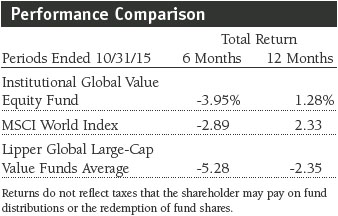
As shown in the Performance Comparison table, the Institutional Global Value Equity Fund returned 1.28% for the 12-month period ended October 31, 2015, after the fund’s 3.95% decline in the last six months eroded gains achieved earlier in the fiscal year. Your fund underperformed the MSCI World Index but outperformed its Lipper peer group average in both periods. Stock selection among capital goods, insurance, and materials firms provided the biggest boost to relative results, while stock selection among semiconductor equipment firms, as well as an underweight in retailing, weighed on relative performance. On a regional basis, stock selection and underweights in Canada and Australia helped, while stock selection in the U.S. detracted, as did stock selection and an overweight in Russia.
Market Environment
Global markets began the six-month period since our last letter on a positive note, holding on to the strong gains they had recorded in 2014 and early 2015. Strengthening economies in the U.S. and much of Europe boosted investor confidence, and companies in many parts of the developed world continued to grow earnings at a faster pace than their overall domestic economies. Investors were also encouraged by continuing monetary stimulus in Europe and Japan, and although the Federal Reserve signaled that it might raise interest rates later in the year, confidence appeared to grow that stocks could weather modest monetary tightening in the U.S.
Global markets reached an inflection point in early August, however. Stocks plunged on most exchanges after China announced a sharp slowdown in its growth rate and surprised investors with a devaluation in its currency, the yuan. The move appeared to be designed to boost China’s export competitiveness, and it set off worries of a round of competitive devaluations by China’s trading partners. More generally, concerns grew that Chinese officials were not successfully guiding a managed slowdown in the world’s second-largest economy—and largest commodity consumer—as it transitioned from a focus on exports to one based on domestic consumption. Commodity prices tumbled in response, and oil prices reached six-year lows as investors worried about the global supply glut meeting reduced Chinese demand.
Stocks recovered some of their footing in the last month of our reporting period, however. Global equity markets surged in October, after European Central Bank President Mario Draghi confirmed that the bank is prepared to expand its stimulus efforts and the People’s Bank of China announced further monetary policy easing. Some disappointing economic data in the U.S. also raised hopes that the Federal Reserve would delay raising interest rates until 2016.
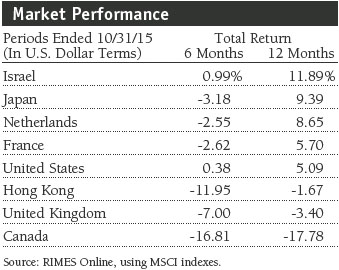
The small Israeli market performed the best over our fiscal year, and the much larger Japanese market was also particularly strong, helped by the falling yen (which reduced returns for U.S. investors) and rising export competitiveness. A new focus on shareholder returns as part of the government’s reform efforts also boosted Japanese stocks. Canada was the worst performer over the fiscal year, with most of the downturn coming in the last six months as the plunge in oil and commodity prices took a toll on this resource-rich economy. The U.S., which makes up over half of the benchmark, performed somewhat better than the overall global market.
Industry performance within the MSCI World Index varied widely. Energy stocks underperformed by some margin, falling over 21%, while materials and banks shares were also weak. Meanwhile, retailing shares rose over 31%, and software and health care equipment and services stocks were also very strong. Despite the benchmark’s modest overall return, 80% of the industry groups (as opposed to sectors) in the MSCI World Index finished our fiscal year with a gain in U.S. dollar terms.
Portfolio Review
Our investment style is valuation and cash flow focused and attempts to discern whether expectations as priced by the market are correct. Our ideal stock is a best-in-class company with durable competitive advantages and strong cash generation that is out of favor for temporary reasons. We are looking for attractive risk/reward opportunities. We are willing to embrace the entire spectrum of value ideas, including lower-quality companies that can offer very high returns if our thesis plays out as expected.
We seek to buy and hold companies where the market undervalues cash generation, fails to look beyond short-term cyclical challenges, or undervalues assets due to temporary problems. Embracing controversy and taking a contrarian stance are at the heart of our investment process. Our goal is to own a broadly diversified portfolio of fundamentally sound companies while maintaining a long-term orientation that allows us to fully exploit any valuation anomalies.

From a geographic perspective, the portfolio’s U.S. stocks represent our largest allocation, at about 54% of assets (along with Canadian shares). We are underweight versus the MSCI World Index, however, as valuations are beginning to look somewhat stretched after a six-year bull market run. Additionally, recent U.S. dollar strength has proven to be a headwind to earnings. The UK and France are our largest country overweights versus the MSCI benchmark.
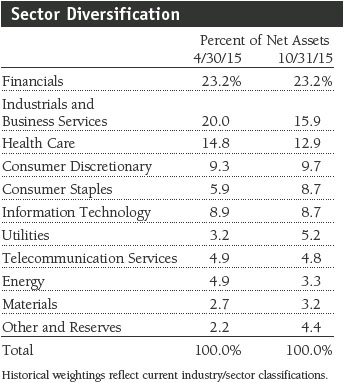
We continue to be attracted to the shareholder focus and activism in the UK, which are especially prevalent across consumer sectors. Our largest UK holdings are Imperial Tobacco and British American Tobacco. Imperial has performed well on the back of solid earnings and has successfully acquired several U.S. cigarette brands as well as the e-cigarette company blu, which offers additional revenue and financial synergies. (Please refer to the portfolio of investments for a complete list of holdings and the amount each represents in the fund.)
We remain underweight in the U.S., which detracted from relative performance. We increased our holdings as the market pulled back in the third quarter, however, as we are attracted to the relatively strong macroeconomic backdrop. In particular, we bought tobacco company Philip Morris International, which generates abundant free cash flow and which we believe offers substantial upside for patient investors. We also bought distressed debt investor Oaktree Capital Partnership, whose core business looks particularly robust and has a proven track record of being able to manage itself well through credit market disruptions. The U.S. has been an overall detractor from relative performance, particularly given that growth continues to outperform. The portfolio’s biggest detractor was Micron Technology, which has suffered from poor results and worries over declining PC demand. We believe such concerns are already fully reflected in the stock price, and we see room for the earnings and demand outlook to improve. Our relative performance was also hurt by not owning Apple, which continues to beat analyst expectations on sales of the iPhone.
Actual and rumored merger and acquisition activity has provided a substantial boost to the health care sector. The Netherlands’ Altice, a media company, significantly outperformed on shrewd acquisitions and persistent takeover rumors. The company has been very successful at allocating capital and continues to pursue this business plan. In the U.S., services company Cigna performed well on rumors—later confirmed—of a takeover by rival Anthem. We also saw good results from Humana, in which we harvested profits, and UnitedHealth Group.
We moved from a neutral to an overweight position in the utilities sector. We have identified several attractive stock-specific opportunities offering reasonable return potential and manageable downside. Our biggest purchase overall in the third quarter was U.S. transmission- and distribution-focused PG&E, which was trading at a 10% discount to the peer group and offered an attractive risk/reward trade-off now that it has shaken off some regulatory concern. We also added China-listed Huaneng Power International, which is cheaply valued, has a reliable dividend, and is well poised to benefit from sharply lower coal prices and continued low interest rates.
Our largest industry group overweight remains capital goods. At a time when the market is charging a sizable premium for defensive, dividend-paying stocks—making opportunities scarcer—we are finding attractive opportunities within the more cyclical areas but with secure dividend payments. While the market has been concerned about the impact of austerity measures on government defense spending for some time, the decline in oil prices has also raised concerns that the airlines will be less inclined to order more efficient airplanes. This controversy is making the sector attractive given our focus on strong, cash-generative business with cyclical sales potential and attractive valuations.
We deepened our underweight position to energy late in the period, eliminating positions in Royal Dutch Shell, BP, Pioneer Resources, Canadian Natural Resources, and Petroleum Geo-Services. A number of energy names need an oil price of $70 per barrel to break even, and we expect to see further earnings misses from many of these former holdings. We invested in Concho Resources, which we believe is the most attractively valued company in the sector. We are being very selective, however, with a focus on risk control.
Investment Outlook
Despite rising volatility and falling markets, we remain cautiously optimistic about the overall outlook for global equities. Diminished fiscal headwinds, an improving credit environment, lower energy costs, and a weaker euro are helping support a nascent recovery in Europe, and Japanese equity valuations have become supportive. We remain cautious about opportunities in the U.S., however. Extended valuations and margins continue to challenge upside potential, while earnings expectations are falling, creating valuation-based risk and the potential for ongoing market volatility. Nevertheless, the labor market recovery and increasingly robust domestic spending suggest that the U.S. is in a steady, albeit slow, recovery, and any rate hikes are likely to be very gradual. Elsewhere in North America, we are finding interesting stock opportunities within Canada, given widening valuation spreads versus the U.S.
Meanwhile, we believe dispersed valuations in emerging markets at country, sector, and stock levels appropriately reflect of the breadth of uncertainty among individual economies and firms. In addition, currency impacts at the country level continue to negate gains, making selectivity essential. Our base-case scenario is that China has the policy tools available to prevent a slowdown from becoming a crisis.
Despite continuing market volatility, we see enough pockets of improvement to retain an overall positive outlook for global equity markets. Notably, we see many companies with strong free cash flow generation that remain underappreciated by the market. These companies have scope to increase shareholder returns while looking attractive on valuation grounds, both within equities and versus many other asset classes. We are still finding pockets where fundamentally sound, well-run businesses face unwarranted investor skepticism. Given our robust research platform and collective experience, we are confident in our ability to find these unique opportunities before their potential for substantial prosperity becomes obvious to other investors.
Thank you for your confidence and for investing with T. Rowe Price.
Respectfully submitted,
Sebastien
Mallet
Chairman of the fund’s Investment
Advisory Committee
November 17, 2015
The committee chairman has day-to-day responsibility for managing the portfolio and works with committee members in developing and executing the fund’s investment program.
| Risks of International Investing |
Funds that invest overseas generally carry more risk than funds that invest strictly in U.S. assets. Funds investing in a single country or in a limited geographic region tend to be riskier than more diversified funds. Risks can result from varying stages of economic and political development; differing regulatory environments, trading days, and accounting standards; and higher transaction costs of non-U.S. markets. Non-U.S. investments are also subject to currency risk, or a decline in the value of a foreign currency versus the U.S. dollar, which reduces the dollar value of securities denominated in that currency.
| Glossary |
Lipper averages: The averages of available mutual fund performance returns for specified periods in categories defined by Lipper Inc.
MSCI World Index: A capitalization-weighted index of stocks from developed and emerging markets worldwide.
Note: MSCI makes no express or implied warranties or representations and shall have no liability whatsoever with respect to any MSCI data contained herein. The MSCI data may not be further redistributed or used as a basis for other indices or any securities or financial products. This report is not approved, reviewed, or produced by MSCI.
Portfolio Highlights
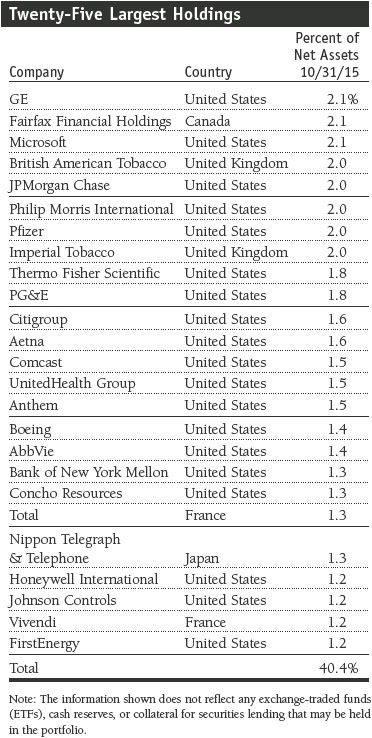
Performance and Expenses
T. Rowe Price Institutional Global Value Equity
Fund
| Growth of $1 Million |
This chart shows the value of a hypothetical $1 million investment in the fund over the past 10 fiscal year periods or since inception (for funds lacking 10-year records). The result is compared with benchmarks, which may include a broad-based market index and a peer group average or index. Market indexes do not include expenses, which are deducted from fund returns as well as mutual fund averages and indexes.
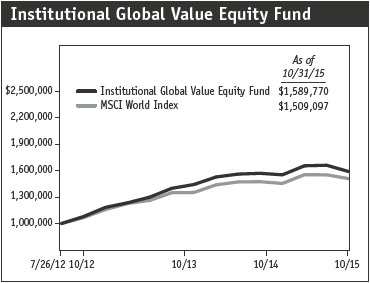
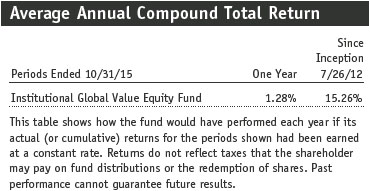
Fund Expense Example
As a mutual fund shareholder, you may incur two types of costs: (1) transaction costs, such as redemption fees or sales loads, and (2) ongoing costs, including management fees, distribution and service (12b-1) fees, and other fund expenses. The following example is intended to help you understand your ongoing costs (in dollars) of investing in the fund and to compare these costs with the ongoing costs of investing in other mutual funds. The example is based on an investment of $1,000 invested at the beginning of the most recent six-month period and held for the entire period.
Actual Expenses
The first line of the following table (Actual) provides
information about actual account values and actual expenses. You may use the
information on this line, together with your account balance, to estimate the
expenses that you paid over the period. Simply divide your account value by
$1,000 (for example, an $8,600 account value divided by $1,000 = 8.6), then
multiply the result by the number on the first line under the heading “Expenses
Paid During Period” to estimate the expenses you paid on your account during
this period.
Hypothetical Example for Comparison
Purposes
The information on the second
line of the table (Hypothetical) is based on hypothetical account values and
expenses derived from the fund’s actual expense ratio and an assumed 5% per year
rate of return before expenses (not the fund’s actual return). You may compare
the ongoing costs of investing in the fund with other funds by contrasting this
5% hypothetical example and the 5% hypothetical examples that appear in the
shareholder reports of the other funds. The hypothetical account values and
expenses may not be used to estimate the actual ending account balance or
expenses you paid for the period.
You should also be aware that the expenses shown in the table highlight only your ongoing costs and do not reflect any transaction costs, such as redemption fees or sales loads. Therefore, the second line of the table is useful in comparing ongoing costs only and will not help you determine the relative total costs of owning different funds. To the extent a fund charges transaction costs, however, the total cost of owning that fund is higher.
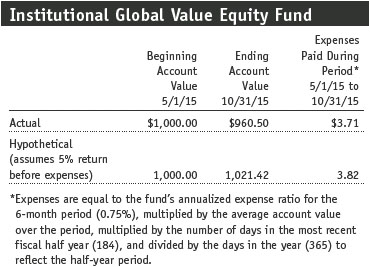
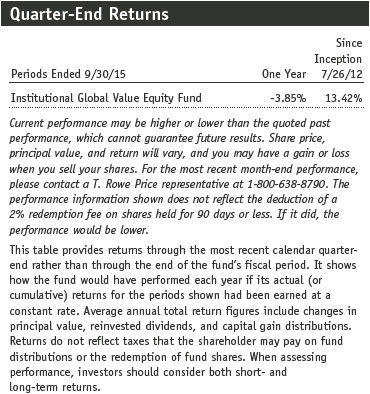
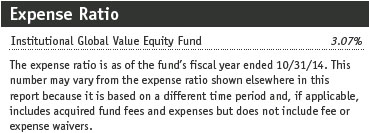
Financial Highlights
T. Rowe Price Institutional Global Value Equity
Fund
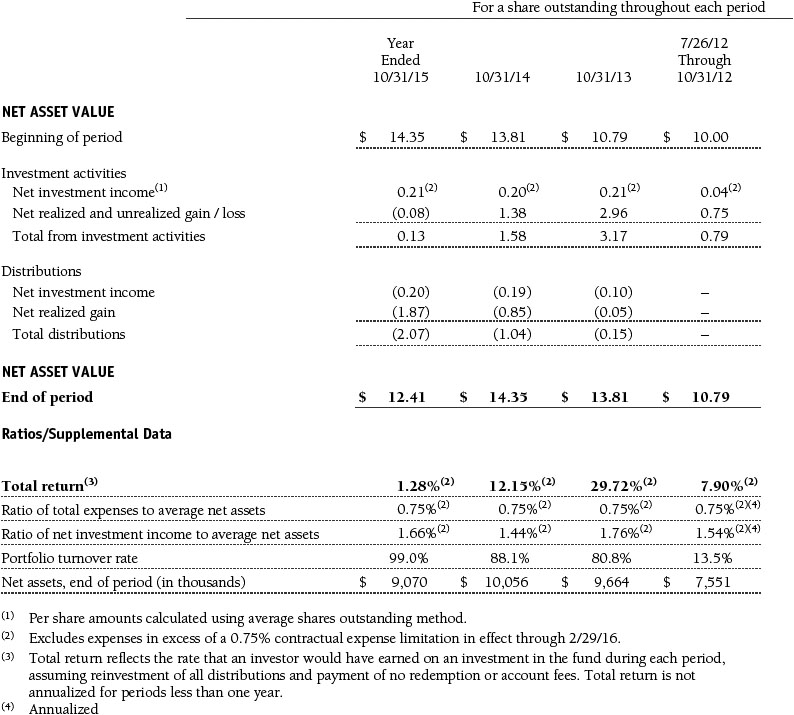
The accompanying notes are an integral part of these financial statements.
Portfolio of Investments‡
T. Rowe Price
Institutional Global Value Equity Fund
October 31, 2015
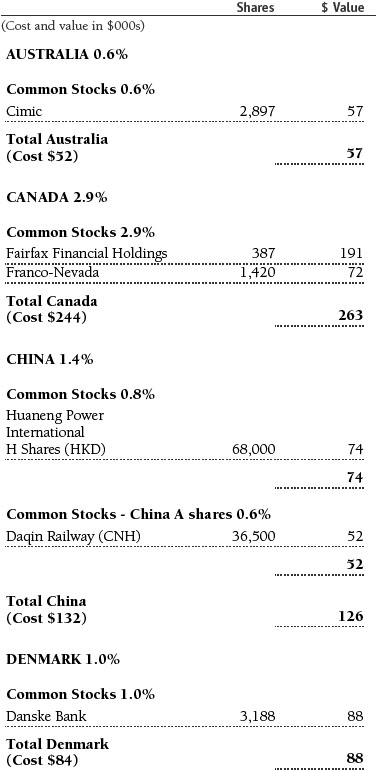
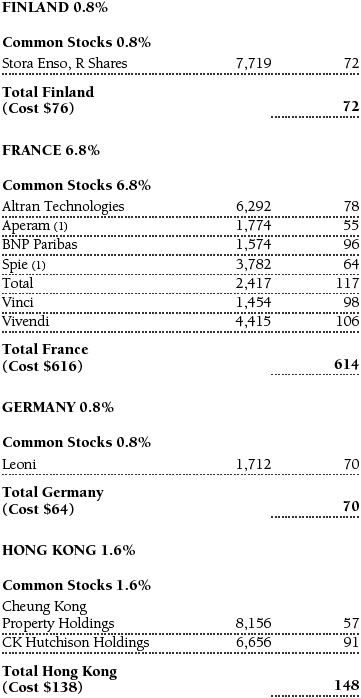
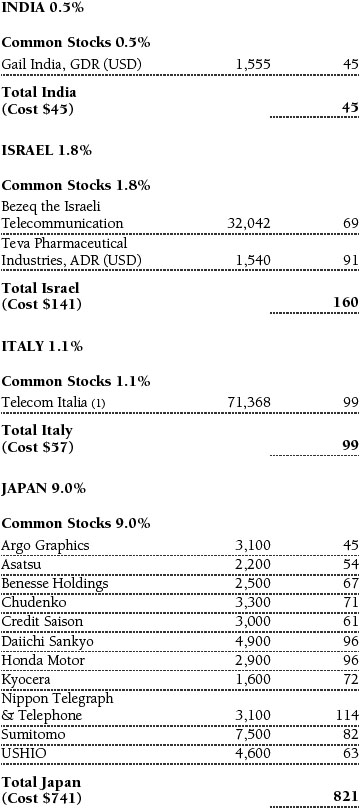
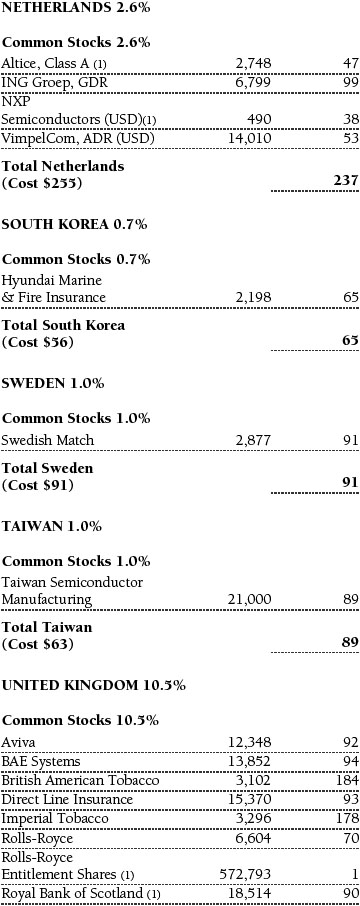

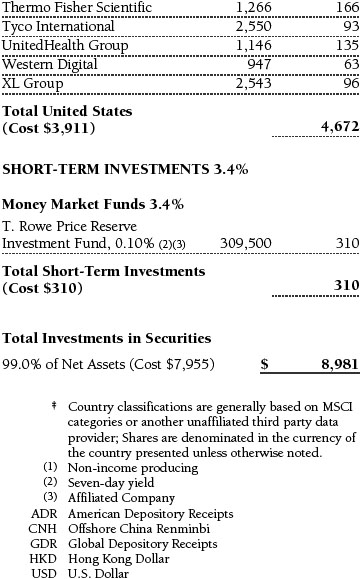
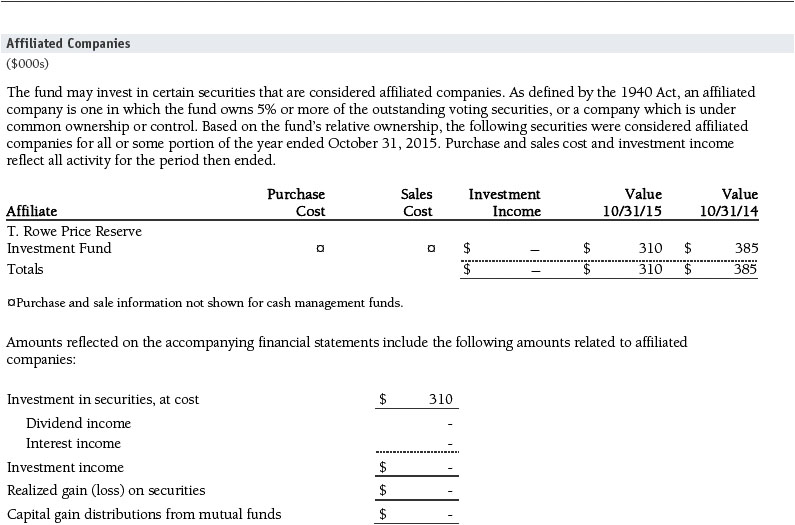
The accompanying notes are an integral part of these financial statements.
Statement of Assets and
Liabilities
T. Rowe Price Institutional
Global Value Equity Fund
October 31, 2015
($000s, except shares and per share amounts)
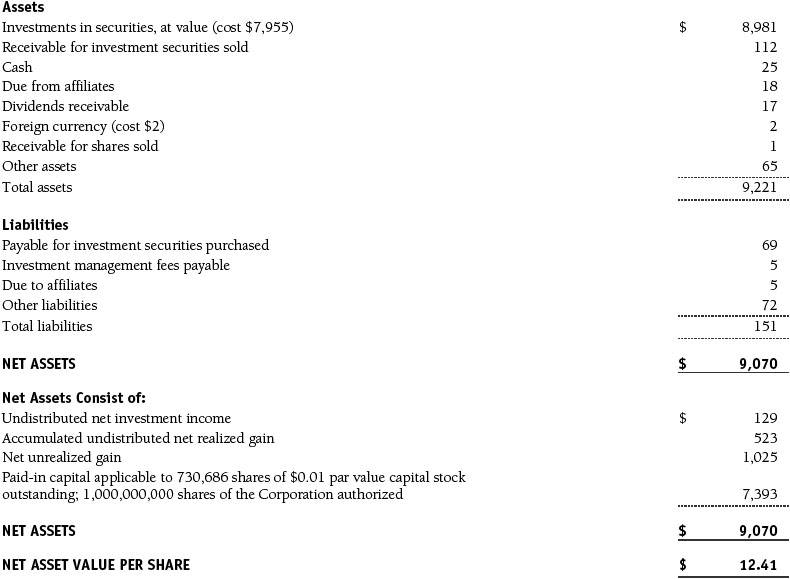
The accompanying notes are an integral part of these financial statements.
Statement of Operations
T. Rowe Price Institutional Global Value Equity
Fund
($000s)
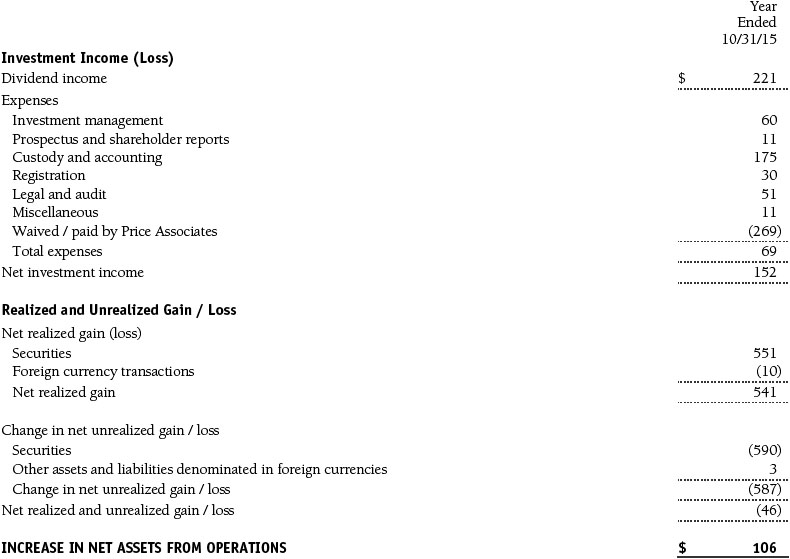
The accompanying notes are an integral part of these financial statements.
Statement of Changes in Net
Assets
T. Rowe Price Institutional Global
Value Equity Fund
($000s)
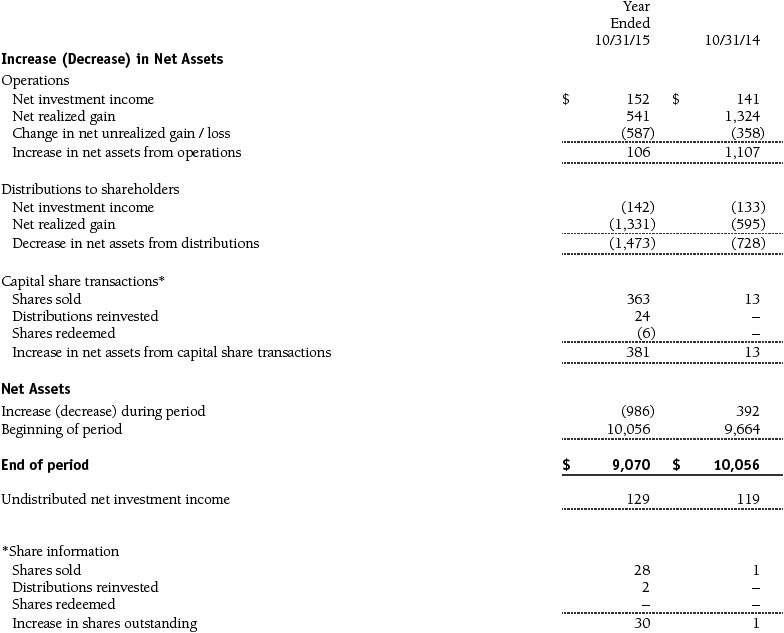
The accompanying notes are an integral part of these financial statements.
Notes to Financial
Statements
T. Rowe Price Institutional
Global Value Equity Fund
October 31, 2015
T. Rowe Price Institutional International Funds, Inc. (the corporation), is registered under the Investment Company Act of 1940 (the 1940 Act). The Institutional Global Value Equity Fund (the fund) is a diversified, open-end management investment company established by the corporation. The fund commenced operations on July 26, 2012. The fund seeks long-term capital appreciation.
NOTE 1 - SIGNIFICANT ACCOUNTING POLICIES
Basis of Preparation The fund is an investment company and follows accounting and reporting guidance in the Financial Accounting Standards Board (FASB) Accounting Standards Codification Topic 946 (ASC 946). The accompanying financial statements were prepared in accordance with accounting principles generally accepted in the United States of America (GAAP), including, but not limited to, ASC 946. GAAP requires the use of estimates made by management. Management believes that estimates and valuations are appropriate; however, actual results may differ from those estimates, and the valuations reflected in the accompanying financial statements may differ from the value ultimately realized upon sale or maturity.
Investment Transactions, Investment Income, and Distributions Income and expenses are recorded on the accrual basis. Dividends received from mutual fund investments are reflected as dividend income; capital gain distributions are reflected as realized gain/loss. Earnings on investments recognized as partnerships for federal income tax purposes reflect the tax character of such earnings. Dividend income and capital gain distributions are recorded on the ex-dividend date. Income tax-related interest and penalties, if incurred, would be recorded as income tax expense. Investment transactions are accounted for on the trade date. Realized gains and losses are reported on the identified cost basis. Distributions to shareholders are recorded on the ex-dividend date. Income distributions are declared and paid annually. Capital gain distributions, if any, are generally declared and paid by the fund annually.
Currency Translation Assets, including investments, and liabilities denominated in foreign currencies are translated into U.S. dollar values each day at the prevailing exchange rate, using the mean of the bid and asked prices of such currencies against U.S. dollars as quoted by a major bank. Purchases and sales of securities, income, and expenses are translated into U.S. dollars at the prevailing exchange rate on the date of the transaction. The effect of changes in foreign currency exchange rates on realized and unrealized security gains and losses is reflected as a component of security gains and losses.
Redemption Fees A 2% fee is assessed on redemptions of fund shares held for 90 days or less to deter short-term trading and to protect the interests of long-term shareholders. Redemption fees are withheld from proceeds that shareholders receive from the sale or exchange of fund shares. The fees are paid to the fund and are recorded as an increase to paid-in capital. The fees may cause the redemption price per share to differ from the net asset value per share.
New Accounting Guidance In May 2015, FASB issued ASU No. 2015-07, Fair Value Measurement (Topic 820), Disclosures for Investments in Certain Entities That Calculate Net Asset Value per Share (or Its Equivalent). The ASU removes the requirement to categorize within the fair value hierarchy all investments for which fair value is measured using the net asset value per share practical expedient and amends certain disclosure requirements for such investments. The ASU is effective for interim and annual reporting periods beginning after December 15, 2015. Adoption will have no effect on the fund’s net assets or results of operations.
NOTE 2 - VALUATION
The fund’s financial instruments are valued and its net asset value (NAV) per share is computed at the close of the New York Stock Exchange (NYSE), normally 4 p.m. ET, each day the NYSE is open for business.
Fair Value The fund’s financial instruments are reported at fair value, which GAAP defines as the price that would be received to sell an asset or paid to transfer a liability in an orderly transaction between market participants at the measurement date. The T. Rowe Price Valuation Committee (the Valuation Committee) has been established by the fund’s Board of Directors (the Board) to ensure that financial instruments are appropriately priced at fair value in accordance with GAAP and the 1940 Act. Subject to oversight by the Board, the Valuation Committee develops and oversees pricing-related policies and procedures and approves all fair value determinations. Specifically, the Valuation Committee establishes procedures to value securities; determines pricing techniques, sources, and persons eligible to effect fair value pricing actions; oversees the selection, services, and performance of pricing vendors; oversees valuation-related business continuity practices; and provides guidance on internal controls and valuation-related matters. The Valuation Committee reports to the Board and has representation from legal, portfolio management and trading, operations, risk management, and the fund’s treasurer.
Various valuation techniques and inputs are used to determine the fair value of financial instruments. GAAP establishes the following fair value hierarchy that categorizes the inputs used to measure fair value:
Level 1 – quoted prices (unadjusted) in active markets for identical financial instruments that the fund can access at the reporting date
Level 2 – inputs other than Level 1 quoted prices that are observable, either directly or indirectly (including, but not limited to, quoted prices for similar financial instruments in active markets, quoted prices for identical or similar financial instruments in inactive markets, interest rates and yield curves, implied volatilities, and credit spreads)
Level 3 – unobservable inputs
Observable inputs are developed using market data, such as publicly available information about actual events or transactions, and reflect the assumptions that market participants would use to price the financial instrument. Unobservable inputs are those for which market data are not available and are developed using the best information available about the assumptions that market participants would use to price the financial instrument. GAAP requires valuation techniques to maximize the use of relevant observable inputs and minimize the use of unobservable inputs. When multiple inputs are used to derive fair value, the financial instrument is assigned to the level within the fair value hierarchy based on the lowest-level input that is significant to the fair value of the financial instrument. Input levels are not necessarily an indication of the risk or liquidity associated with financial instruments at that level but rather the degree of judgment used in determining those values.
Valuation Techniques Equity securities listed or regularly traded on a securities exchange or in the over-the-counter (OTC) market are valued at the last quoted sale price or, for certain markets, the official closing price at the time the valuations are made. OTC Bulletin Board securities are valued at the mean of the closing bid and asked prices. A security that is listed or traded on more than one exchange is valued at the quotation on the exchange determined to be the primary market for such security. Listed securities not traded on a particular day are valued at the mean of the closing bid and asked prices for domestic securities and the last quoted sale or closing price for international securities.
For valuation purposes, the last quoted prices of non-U.S. equity securities may be adjusted to reflect the fair value of such securities at the close of the NYSE. If the fund determines that developments between the close of a foreign market and the close of the NYSE will, in its judgment, materially affect the value of some or all of its portfolio securities, the fund will adjust the previous quoted prices to reflect what it believes to be the fair value of the securities as of the close of the NYSE. In deciding whether it is necessary to adjust quoted prices to reflect fair value, the fund reviews a variety of factors, including developments in foreign markets, the performance of U.S. securities markets, and the performance of instruments trading in U.S. markets that represent foreign securities and baskets of foreign securities. The fund may also fair value securities in other situations, such as when a particular foreign market is closed but the fund is open. The fund uses outside pricing services to provide it with quoted prices and information to evaluate or adjust those prices. The fund cannot predict how often it will use quoted prices and how often it will determine it necessary to adjust those prices to reflect fair value. As a means of evaluating its security valuation process, the fund routinely compares quoted prices, the next day’s opening prices in the same markets, and adjusted prices.
Actively traded equity securities listed on a domestic exchange generally are categorized in Level 1 of the fair value hierarchy. Non-U.S. equity securities generally are categorized in Level 2 of the fair value hierarchy despite the availability of quoted prices because, as described above, the fund evaluates and determines whether those quoted prices reflect fair value at the close of the NYSE or require adjustment. OTC Bulletin Board securities, certain preferred securities, and equity securities traded in inactive markets generally are categorized in Level 2 of the fair value hierarchy.
Investments in mutual funds are valued at the mutual fund’s closing NAV per share on the day of valuation and are categorized in Level 1 of the fair value hierarchy. Assets and liabilities other than financial instruments, including short-term receivables and payables, are carried at cost, or estimated realizable value, if less, which approximates fair value.
Thinly traded financial instruments and those for which the above valuation procedures are inappropriate or are deemed not to reflect fair value are stated at fair value as determined in good faith by the Valuation Committee. The objective of any fair value pricing determination is to arrive at a price that could reasonably be expected from a current sale. Financial instruments fair valued by the Valuation Committee are primarily private placements, restricted securities, warrants, rights, and other securities that are not publicly traded.
Subject to oversight by the Board, the Valuation Committee regularly makes good faith judgments to establish and adjust the fair valuations of certain securities as events occur and circumstances warrant. For instance, in determining the fair value of an equity investment with limited market activity, such as a private placement or a thinly traded public company stock, the Valuation Committee considers a variety of factors, which may include, but are not limited to, the issuer’s business prospects, its financial standing and performance, recent investment transactions in the issuer, new rounds of financing, negotiated transactions of significant size between other investors in the company, relevant market valuations of peer companies, strategic events affecting the company, market liquidity for the issuer, and general economic conditions and events. In consultation with the investment and pricing teams, the Valuation Committee will determine an appropriate valuation technique based on available information, which may include both observable and unobservable inputs. The Valuation Committee typically will afford greatest weight to actual prices in arm’s length transactions, to the extent they represent orderly transactions between market participants, transaction information can be reliably obtained, and prices are deemed representative of fair value. However, the Valuation Committee may also consider other valuation methods such as market-based valuation multiples; a discount or premium from market value of a similar, freely traded security of the same issuer; or some combination. Fair value determinations are reviewed on a regular basis and updated as information becomes available, including actual purchase and sale transactions of the issue. Because any fair value determination involves a significant amount of judgment, there is a degree of subjectivity inherent in such pricing decisions, and fair value prices determined by the Valuation Committee could differ from those of other market participants. Depending on the relative significance of unobservable inputs, including the valuation technique(s) used, fair valued securities may be categorized in Level 2 or 3 of the fair value hierarchy.
Valuation Inputs The following table summarizes the fund’s financial instruments, based on the inputs used to determine their fair values on October 31, 2015:
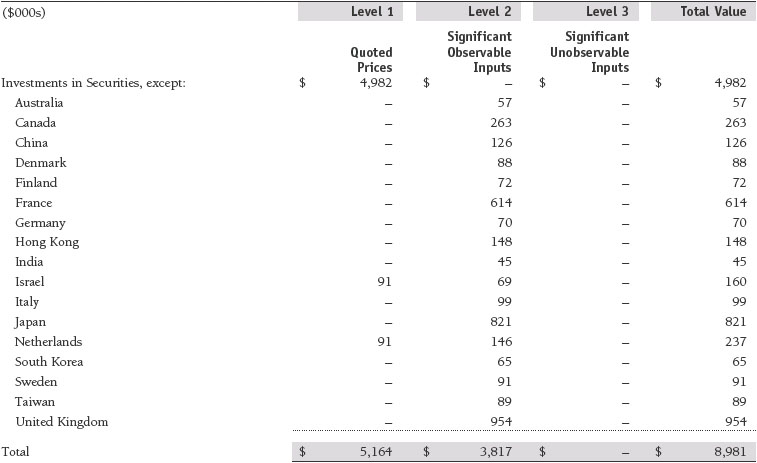
There were no material transfers between Levels 1 and 2 during the year ended October 31, 2015.
NOTE 3 - DERIVATIVE INSTRUMENTS
During the year ended October 31, 2015, the fund invested in derivative instruments. As defined by GAAP, a derivative is a financial instrument whose value is derived from an underlying security price, foreign exchange rate, interest rate, index of prices or rates, or other variable; it requires little or no initial investment and permits or requires net settlement. The fund invests in derivatives only if the expected risks and rewards are consistent with its investment objectives, policies, and overall risk profile, as described in its prospectus and Statement of Additional Information. The fund may use derivatives for a variety of purposes, such as seeking to hedge against declines in principal value, increase yield, invest in an asset with greater efficiency and at a lower cost than is possible through direct investment, or to adjust credit exposure. The risks associated with the use of derivatives are different from, and potentially much greater than, the risks associated with investing directly in the instruments on which the derivatives are based. The fund at all times maintains sufficient cash reserves, liquid assets, or other SEC-permitted asset types to cover its settlement obligations under open derivative contracts.
The fund values its derivatives at fair value, as described in Note 2, and recognizes changes in fair value currently in its results of operations. Accordingly, the fund does not follow hedge accounting, even for derivatives employed as economic hedges. Generally, the fund accounts for its derivatives on a gross basis. It does not offset the fair value of derivative liabilities against the fair value of derivative assets on its financial statements, nor does it offset the fair value of derivative instruments against the right to reclaim or obligation to return collateral. As of October 31, 2015, the fund held no derivative instruments.
Additionally, during the year ended October 31, 2015, the fund recognized $9,000 of realized loss on Foreign Currency Transactions and a $4,000 change in unrealized gain/loss on Foreign Currency Transactions related to its investments in foreign exchange derivatives; such amounts are included on the accompanying Statement of Operations.
Forward Currency Exchange Contracts The fund is subject to foreign currency exchange rate risk in the normal course of pursuing its investment objectives. It uses forward currency exchange contracts (forwards) primarily to protect its non-U.S. dollar-denominated securities from adverse currency movements relative to the U.S. dollar. A forward involves an obligation to purchase or sell a fixed amount of a specific currency on a future date at a price set at the time of the contract. Although certain forwards may be settled by exchanging only the net gain or loss on the contract, most forwards are settled with the exchange of the underlying currencies in accordance with the specified terms. Forwards are valued at the unrealized gain or loss on the contract, which reflects the net amount the fund either is entitled to receive or obligated to deliver, as measured by the difference between the forward exchange rates at the date of entry into the contract and the forward rates at the reporting date. Appreciated forwards are reflected as assets and depreciated forwards are reflected as liabilities on the accompanying Statement of Assets and Liabilities. Risks related to the use of forwards include the possible failure of counterparties to meet the terms of the agreements; that anticipated currency movements will not occur, thereby reducing the fund’s total return; and the potential for losses in excess of the fund’s initial investment. During the year ended October 31, 2015, the volume of the fund’s activity in forwards, based on underlying notional amounts, was generally between 0% and 2% of net assets.
NOTE 4 - OTHER INVESTMENT TRANSACTIONS
Purchases and sales of portfolio securities other than short-term securities aggregated $8,810,000 and $9,737,000, respectively, for the year ended October 31, 2015.
NOTE 5 - FEDERAL INCOME TAXES
No provision for federal income taxes is required since the fund intends to continue to qualify as a regulated investment company under Subchapter M of the Internal Revenue Code and distribute to shareholders all of its taxable income and gains. Distributions determined in accordance with federal income tax regulations may differ in amount or character from net investment income and realized gains for financial reporting purposes. Financial reporting records are adjusted for permanent book/tax differences to reflect tax character but are not adjusted for temporary differences.
The fund files U.S. federal, state, and local tax returns as required. The fund’s tax returns are subject to examination by the relevant tax authorities until expiration of the applicable statute of limitations, which is generally three years after the filing of the tax return but which can be extended to six years in certain circumstances. Tax returns for open years have incorporated no uncertain tax positions that require a provision for income taxes.
Distributions during the ended October 31, 2015 and October 31, 2014, were characterized for tax purposes as follows:

At October 31, 2015, the tax-basis cost of investments and components of net assets were as follows:

The difference between book-basis and tax-basis net unrealized appreciation (depreciation) is attributable to the deferral of losses from wash sales and the realization of gains/losses on passive foreign investment companies for tax purposes.
NOTE 6 - RELATED PARTY TRANSACTIONS
The fund is managed by T. Rowe Price Associates, Inc. (Price Associates), a wholly owned subsidiary of T. Rowe Price Group, Inc. (Price Group). Price Associates has entered into a subadvisory agreement(s) with one or more of its wholly owned subsidiaries, to provide investment advisory services to the fund. The investment management agreement between the fund and Price Associates provides for an annual investment management fee equal 0.65% of the fund’s average daily net assets. The fee is computed daily and paid monthly.
The fund is also subject to a contractual expense limitation through February 29, 2016. During the limitation period, Price Associates is required to waive its management fee and pay the fund for any expenses, excluding interest, taxes, brokerage commissions, and extraordinary expenses, that would otherwise cause the fund’s ratio of annualized total expenses to average net assets (expense ratio) to exceed its expense limitation of 0.75%. The fund is required to repay Price Associates for expenses previously waived/paid to the extent its net assets grow or expenses decline sufficiently to allow repayment without causing the fund’s expense ratio to exceed its expense limitation. However, no repayment will be made more than three years after the date of a payment or waiver. Pursuant to this agreement, $269,000 of expenses were waived/paid by Price Associates during the year ended October 31, 2015. Including these amounts, management fees waived and expenses previously paid by Price Associates in the amount of $756,000 remain subject to repayment by the fund at October 31, 2015.
In addition, the fund has entered into service agreements with Price Associates and a wholly owned subsidiary of Price Associates (collectively, Price). Price Associates provides certain accounting and administrative services to the fund. T. Rowe Price Services, Inc., provides shareholder and administrative services in its capacity as the fund’s transfer and dividend-disbursing agent. For the year ended October 31, 2015, expenses incurred pursuant to these service agreements were $123,000 for Price Associates and less than $1,000 for T. Rowe Price Services, Inc. The total amount payable at period-end pursuant to these service agreements is reflected as Due to Affiliates in the accompanying financial statements.
The fund may invest in the T. Rowe Price Reserve Investment Fund, the T. Rowe Price Government Reserve Investment Fund, or the T. Rowe Price Short-Term Reserve Fund (collectively, the Price Reserve Investment Funds), open-end management investment companies managed by Price Associates and considered affiliates of the fund. The Price Reserve Investment Funds are offered as short-term investment options to mutual funds, trusts, and other accounts managed by Price Associates or its affiliates and are not available for direct purchase by members of the public. The Price Reserve Investment Funds pay no investment management fees.
As of October 31, 2015, T. Rowe Price Group, Inc., or its wholly owned subsidiaries owned 700,000 shares of the fund, representing 96% of the fund’s net assets.
Report of Independent Registered Public Accounting Firm
To the Board of Directors of T. Rowe
Price Institutional International Funds, Inc. and
Shareholders of T. Rowe
Price Institutional Global Value Equity Fund
In our opinion, the accompanying statement of assets and liabilities, including the portfolio of investments, and the related statements of operations and of changes in net assets and the financial highlights present fairly, in all material respects, the financial position of T. Rowe Price Institutional Global Value Equity Fund (one of the portfolios comprising T. Rowe Price Institutional International Funds, Inc., hereafter referred to as the “Fund”) at October 31, 2015, the results of its operations, the changes in its net assets and the financial highlights for each of the periods indicated therein, in conformity with accounting principles generally accepted in the United States of America. These financial statements and financial highlights (hereafter referred to as “financial statements”) are the responsibility of the Fund’s management. Our responsibility is to express an opinion on these financial statements based on our audits. We conducted our audits of these financial statements in accordance with the standards of the Public Company Accounting Oversight Board (United States). Those standards require that we plan and perform the audit to obtain reasonable assurance about whether the financial statements are free of material misstatement. An audit includes examining, on a test basis, evidence supporting the amounts and disclosures in the financial statements, assessing the accounting principles used and significant estimates made by management, and evaluating the overall financial statement presentation. We believe that our audits, which included confirmation of securities at October 31, 2015 by correspondence with the custodian and brokers, and confirmation of the underlying fund by correspondence with the transfer agent, provide a reasonable basis for our opinion.
PricewaterhouseCoopers LLP
Baltimore,
Maryland
December 15, 2015
| Tax Information (Unaudited) for the Tax Year Ended 10/31/15 |
We are providing this information as required by the Internal Revenue Code. The amounts shown may differ from those elsewhere in this report because of differences between tax and financial reporting requirements.
The fund’s distributions to shareholders included:
| ● | $256,000 from short-term capital
gains, |
| ● |
$1,074,000 from long-term capital gains, subject to a long-term capital gains tax rate of not greater than 20% |
For taxable non-corporate shareholders, $195,000 of the fund’s income represents qualified dividend income subject to a long-term capital gains tax rate of not greater than 20%.
For corporate shareholders, $85,000 of the fund’s income qualifies for the dividends-received deduction.
| Information on Proxy Voting Policies, Procedures, and Records |
A description of the policies and procedures used by T. Rowe Price funds and portfolios to determine how to vote proxies relating to portfolio securities is available in each fund’s Statement of Additional Information. You may request this document by calling 1-800-225-5132 or by accessing the SEC’s website, sec.gov.
The description of our proxy voting policies and procedures is also available on our website, troweprice.com. To access it, click on the words “Social Responsibility” at the top of our corporate homepage. Next, click on the words “Conducting Business Responsibly” on the left side of the page that appears. Finally, click on the words “Proxy Voting Policies” on the left side of the page that appears.
Each fund’s most recent annual proxy voting record is available on our website and through the SEC’s website. To access it through our website, follow the directions above to reach the “Conducting Business Responsibly” page. Click on the words “Proxy Voting Records” on the left side of that page, and then click on the “View Proxy Voting Records” link at the bottom of the page that appears.
| How to Obtain Quarterly Portfolio Holdings |
The fund files a complete schedule of portfolio holdings with the Securities and Exchange Commission for the first and third quarters of each fiscal year on Form N-Q. The fund’s Form N-Q is available electronically on the SEC’s website (sec.gov); hard copies may be reviewed and copied at the SEC’s Public Reference Room, 100 F St. N.E., Washington, DC 20549. For more information on the Public Reference Room, call 1-800-SEC-0330.
| About the Fund’s Directors and Officers |
Your fund is overseen by a Board of Directors (Board) that meets regularly to review a wide variety of matters affecting or potentially affecting the fund, including performance, investment programs, compliance matters, advisory fees and expenses, service providers, and business and regulatory affairs. The Board elects the fund’s officers, who are listed in the final table. At least 75% of the Board’s members are independent of T. Rowe Price Associates, Inc. (T. Rowe Price), and its affiliates; “inside” or “interested” directors are employees or officers of T. Rowe Price. The business address of each director and officer is 100 East Pratt Street, Baltimore, Maryland 21202. The Statement of Additional Information includes additional information about the fund directors and is available without charge by calling a T. Rowe Price representative at 1-800-638-5660.
| Independent Directors | ||
| Name (Year of Birth) Year Elected* [Number of T. Rowe Price Portfolios Overseen] |
Principal Occupation(s) and Directorships of Public Companies and Other Investment Companies During the Past Five Years | |
| William R. Brody, M.D., Ph.D. (1944) 2009 [179] |
President and Trustee, Salk Institute for Biological Studies (2009 to present); Director, BioMed Realty Trust (2013 to present); Director, Novartis, Inc. (2009 to 2014); Director, IBM (2007 to present) | |
| Anthony W. Deering (1945) 1991 [179] |
Chairman, Exeter Capital, LLC, a private investment firm (2004 to present); Director, Brixmor Real Estate Investment Trust (2012 to present); Director and Advisory Board Member, Deutsche Bank North America (2004 to present); Director, Under Armour (2008 to present); Director, Vornado Real Estate Investment Trust (2004 to 2012) | |
| Donald W. Dick, Jr. (1943) 1989 [179] |
Principal, EuroCapital Partners, LLC, an acquisition and management advisory firm (1995 to present) | |
| Bruce
W. Duncan (1951) 2013 [179] |
President, Chief Executive Officer, and Director, First Industrial Realty Trust, an owner and operator of industrial properties (2009 to present); Chairman of the Board (2005 to present) and Director (1999 to present), Starwood Hotels & Resorts, a hotel and leisure company | |
| Robert J. Gerrard, Jr. (1952) 2012 [179] |
Chairman of Compensation Committee and Director, Syniverse Holdings, Inc., a provider of wireless voice and data services for telecommunications companies (2008 to 2011); Advisory Board Member, Pipeline Crisis/Winning Strategies, a collaborative working to improve opportunities for young African Americans (1997 to present) | |
| Karen
N. Horn (1943) 2003 [179] |
Limited Partner and Senior Managing Director, Brock Capital Group, an advisory and investment banking firm (2004 to present); Director, Eli Lilly and Company (1987 to present); Director, Simon Property Group (2004 to present); Director, Norfolk Southern (2008 to present) | |
| Paul
F. McBride (1956) 2013 [179] |
Former Company Officer and Senior Vice President, Human Resources and Corporate Initiatives, Black & Decker Corporation (2004 to 2010) | |
| Cecilia E. Rouse, Ph.D. (1963) 2012 [179] |
Dean, Woodrow Wilson School (2012 to present); Professor and Researcher, Princeton University (1992 to present); Director, MDRC, a nonprofit education and social policy research organization (2011 to present); Member, National Academy of Education (2010 to present); Research Associate, National Bureau of Economic Research’s Labor Studies Program (2011 to present); Member, President’s Council of Economic Advisers (2009 to 2011); Chair of Committee on the Status of Minority Groups in the Economic Profession, American Economic Association (2012 to present) | |
| John
G. Schreiber (1946) 2001 [179] |
Owner/President, Centaur Capital Partners, Inc., a real estate investment company (1991 to present); Cofounder and Partner, Blackstone Real Estate Advisors, L.P. (1992 to present); Director, General Growth Properties, Inc. (2010 to 2013); Director, Blackstone Mortgage Trust, a real estate financial company (2012 to present); Director and Chairman of the Board, Brixmor Property Group, Inc. (2013 to present); Director, Hilton Worldwide (2013 to present); Director, Hudson Pacific Properties (2014 to present) | |
| Mark
R. Tercek (1957) 2009 [179] |
President and Chief Executive Officer, The Nature Conservancy (2008 to present) | |
| *Each independent director serves until retirement, resignation, or election of a successor. | ||
| Inside Directors | ||
| Name (Year of
Birth) Year Elected* [Number of T. Rowe Price Portfolios Overseen] |
Principal Occupation(s) and Directorships of Public Companies and Other Investment Companies During the Past Five Years | |
| Edward C. Bernard (1956) 2006 [179] |
Director and Vice President, T. Rowe Price; Vice Chairman of the Board, Director, and Vice President, T. Rowe Price Group, Inc.; Chairman of the Board, Director, and President, T. Rowe Price Investment Services, Inc.; Chairman of the Board and Director, T. Rowe Price Retirement Plan Services, Inc., and T. Rowe Price Services, Inc.; Chairman of the Board, Chief Executive Officer, and Director, T. Rowe Price International; Chairman of the Board, Chief Executive Officer, Director, and President, T. Rowe Price Trust Company; Chairman of the Board, all funds | |
| Brian
C. Rogers, CFA, CIC (1955) 2006 [125] |
Chief Investment Officer, Director, and Vice President, T. Rowe Price; Chairman of the Board, Chief Investment Officer, Director, and Vice President, T. Rowe Price Group, Inc.; Vice President, T. Rowe Price Trust Company | |
| *Each inside director serves until retirement, resignation, or election of a successor. | ||
| Officers | ||
| Name (Year of
Birth) Position Held With Institutional International Funds |
Principal Occupation(s) | |
| Ulle Adamson, CFA
(1979) Vice President |
Vice President, T. Rowe Price Group, Inc., and T. Rowe Price International | |
| Roy H. Adkins
(1970) Vice President |
Vice President, T. Rowe Price Group, Inc., and T. Rowe Price International | |
| Christopher D.
Alderson (1962) President |
Company’s Representative, Director, and Vice President, Price Hong Kong; Director and Vice President, Price Singapore and T. Rowe Price International; Vice President, T. Rowe Price Group, Inc. | |
| Paulina Amieva
(1981) Vice President |
Vice President, T. Rowe Price and T. Rowe Price Group, Inc. | |
| Malik S. Asif
(1981) Vice President |
Vice President, T. Rowe Price Group, Inc., and T. Rowe Price International; formerly, student, The University of Chicago Booth School of Business (to 2012); Investment Consultant–Middle East and North Africa Investment Team, International Finance Corporation–The World Bank Group (to 2010) | |
| Harishankar
Balkrishna (1983) Vice President |
Vice President, T. Rowe Price Group, Inc., and T. Rowe Price International; formerly, intern, T. Rowe Price (to 2010) | |
| Peter J. Bates, CFA
(1974) Vice President |
Vice President, T. Rowe Price and T. Rowe Price Group, Inc. | |
| Oliver D.M. Bell,
IMC (1969) Executive Vice President |
Vice President, T. Rowe Price Group, Inc., and T. Rowe Price International; formerly, Head of Global Emerging Markets Research, Pictet Asset Management Ltd. (to 2011) | |
| R. Scott Berg, CFA
(1972) Executive Vice President |
Vice President, T. Rowe Price and T. Rowe Price Group, Inc. | |
| Steven E. Boothe,
CFA (1977) Vice President |
Vice President, T. Rowe Price and T. Rowe Price Group, Inc. | |
| Peter I. Botoucharov
(1965) Vice President |
Vice President, T. Rowe Price Group, Inc., and T. Rowe Price International; formerly, Director, EMEA Macroeconomic Research and Strategy (to 2012); Independent Financial Advisor, Global Source (to 2010) | |
| Tala Boulos
(1984) Vice President |
Vice President, T. Rowe Price Group, Inc., and T. Rowe Price International; formerly, Vice President, CEEMEA Corporate Credit Research, Deutsche Bank (to 2013) | |
| Darrell N. Braman
(1963) Vice President |
Vice President, Price Hong Kong, Price Singapore, T. Rowe Price, T. Rowe Price Group, Inc., T. Rowe Price International, T. Rowe Price Investment Services, Inc., and T. Rowe Price Services, Inc. | |
| Carolyn Hoi Che Chu
(1974) Vice President |
Vice President, Price Hong Kong and T. Rowe Price Group, Inc.; formerly, Director, Bank of America Merrill Lynch and Co-head of credit and convertibles research team in Hong Kong (to 2010) | |
| Archibald Ciganer
Albeniz, CFA (1976) Vice President |
Vice President, T. Rowe Price Group, Inc., and T. Rowe Price International | |
| Richard N.
Clattenburg, CFA (1979) Executive Vice President |
Vice President, Price Singapore, T. Rowe Price, T. Rowe Price Group, Inc., and T. Rowe Price International | |
| Michael J. Conelius,
CFA (1964) Executive Vice President |
Vice President, T. Rowe Price, T. Rowe Price Group, Inc., T. Rowe Price International, and T. Rowe Price Trust Company | |
| Richard de los Reyes
(1975) Vice President |
Vice President, T. Rowe Price, T. Rowe Price Group, Inc., and T. Rowe Price Trust Company | |
| Laurent Delgrande
(1971) Vice President |
Vice President, T. Rowe Price Group, Inc., and T. Rowe Price International; formerly, Portfolio Manager, Fidelity International Limited (to 2014) | |
| Michael Della Vedova
(1969) Vice President |
Vice President, T. Rowe Price Group, Inc., and T. Rowe Price International | |
| Shawn T. Driscoll
(1975) Vice President |
Vice President, T. Rowe Price, T. Rowe Price Group, Inc., and T. Rowe Price Trust Company | |
| Bridget A. Ebner
(1970) Vice President |
Vice President, T. Rowe Price and T. Rowe Price Group, Inc. | |
| Mark J.T. Edwards
(1957) Executive Vice President |
Vice President, T. Rowe Price Group, Inc., and T. Rowe Price International | |
| David J. Eiswert,
CFA (1972) Executive Vice President |
Vice President, T. Rowe Price, T. Rowe Price Group, Inc., and T. Rowe Price International | |
| Mark S. Finn, CFA,
CPA (1963) Vice President |
Vice President, T. Rowe Price, T. Rowe Price Group, Inc., and T. Rowe Price Trust Company | |
| John R. Gilner
(1961) Chief Compliance Officer |
Chief Compliance Officer and Vice President, T. Rowe Price; Vice President, T. Rowe Price Group, Inc., and T. Rowe Price Investment Services, Inc. | |
| Paul D. Greene II
(1978) Vice President |
Vice President, T. Rowe Price and T. Rowe Price Group, Inc. | |
| Benjamin Griffiths,
CFA (1977) Vice President |
Vice President, T. Rowe Price Group, Inc., and T. Rowe Price International | |
| Richard L. Hall
(1979) Vice President |
Vice President, T. Rowe Price and T. Rowe Price Group, Inc.; formerly, Financial Attaché, U.S. Department of Treasury, International Affairs Division (to 2012) | |
| Steven C. Huber,
CFA, FSA (1958) Vice President |
Vice President, T. Rowe Price and T. Rowe Price Group, Inc. | |
| Stefan Hubrich,
Ph.D., CFA (1974) Vice President |
Vice President, T. Rowe Price and T. Rowe Price Group, Inc. | |
| Arif Husain, CFA
(1972) Executive Vice President |
Vice President, T. Rowe Price Group, Inc., and T. Rowe Price International; formerly, Director/Head of UK and Euro Fixed Income, AllianceBernstein (to 2013) | |
| Dominic Janssens
(1965) Vice President |
Vice President, T. Rowe Price, T. Rowe Price Group, Inc., and T. Rowe Price Trust Company | |
| Randal S. Jenneke
(1971) Vice President |
Vice President, T. Rowe Price Group, Inc., and T. Rowe Price International; formerly, Senior Portfolio Manager, Australian Equities (to 2010) | |
| Yoichiro Kai
(1973) Vice President |
Vice President, T. Rowe Price Group, Inc., and T. Rowe Price International | |
| Andrew J. Keirle
(1974) Executive Vice President |
Vice President, T. Rowe Price Group, Inc., and T. Rowe Price International | |
| Paul J. Krug
(1964) Vice President |
Vice President, T. Rowe Price and T. Rowe Price Trust Company | |
| Christopher J.
Kushlis, CFA (1976) Vice President |
Vice President, T. Rowe Price Group, Inc., and T. Rowe Price International | |
| Mark J. Lawrence
(1970) Vice President |
Vice President, T. Rowe Price Group, Inc., and T. Rowe Price International | |
| David M. Lee, CFA
(1962) Vice President |
Vice President, T. Rowe Price, T. Rowe Price Group, Inc., and T. Rowe Price Trust Company | |
| Patricia B. Lippert
(1953) Secretary |
Assistant Vice President, T. Rowe Price and T. Rowe Price Investment Services, Inc. | |
| Christopher C. Loop,
CFA (1966) Vice President |
Vice President, T. Rowe Price Group, Inc., and T. Rowe Price International | |
| Anh Lu
(1968) Vice President |
Vice President, Price Hong Kong and T. Rowe Price Group, Inc. | |
| Sebastien Mallet
(1974) Executive Vice President |
Vice President, T. Rowe Price Group, Inc., and T. Rowe Price International | |
| Catherine D. Mathews
(1963) Treasurer and Vice President |
Vice President, T. Rowe Price and T. Rowe Price Trust Company | |
| Jonathan H.W.
Matthews, CFA (1975) Vice President |
Vice President, T. Rowe Price Group, Inc., and T. Rowe Price International | |
| Raymond A. Mills,
Ph.D., CFA (1960) Executive Vice President |
Vice President, T. Rowe Price, T. Rowe Price Group, Inc., T. Rowe Price International, and T. Rowe Price Trust Company | |
| Sudhir Nanda, Ph.D.,
CFA (1959) Vice President |
Vice President, T. Rowe Price and T. Rowe Price Group, Inc. | |
| Joshua Nelson
(1977) Executive Vice President |
Vice President, T. Rowe Price and T. Rowe Price Group, Inc. | |
| Sridhar Nishtala
(1975) Vice President |
Vice President, Price Singapore and T. Rowe Price Group, Inc. | |
| Jason Nogueira, CFA
(1974) Executive Vice President |
Vice President, T. Rowe Price and T. Rowe Price Group, Inc. | |
| David Oestreicher
(1967) Vice President |
Director, Vice President, and Secretary, T. Rowe Price Investment Services, Inc., T. Rowe Price Retirement Plan Services, Inc., T. Rowe Price Services, Inc., and T. Rowe Price Trust Company; Chief Legal Officer, Vice President, and Secretary, T. Rowe Price Group, Inc.; Vice President and Secretary, T. Rowe Price and T. Rowe Price International; Vice President, Price Hong Kong and Price Singapore | |
| Michael D. Oh, CFA
(1974) Vice President |
Vice President, T. Rowe Price and T. Rowe Price Group, Inc. | |
| Kenneth A. Orchard
(1975) Vice President |
Vice President, T. Rowe Price Group, Inc., and T. Rowe Price International; formerly, Vice President, Moody’s Investors Service (to 2010) | |
| Oluwaseun A.
Oyegunle, CFA (1984) Vice President |
Vice President, T. Rowe Price International; formerly, student, The Wharton School, University of Pennsylvania (to 2013); Summer Investment Analyst, T. Rowe Price International (2012); Analyst, Asset & Resource Management Limited (to 2012); Analyst, Vetiva Capital Management Limited (to 2011) | |
| Gonzalo Pángaro, CFA
(1968) Executive Vice President |
Vice President, T. Rowe Price Group, Inc., and T. Rowe Price International | |
| Craig J. Pennington,
CFA (1971) Vice President |
Vice President, T. Rowe Price Group, Inc., and T. Rowe Price International; formerly, Global Energy Analyst, Insight Investment (to 2010) | |
| John W. Ratzesberger
(1975) Vice President |
Vice President, T. Rowe Price, T. Rowe Price Group, Inc., and T. Rowe Price Trust Company; formerly, North American Head of Listed Derivatives Operation, Morgan Stanley (to 2013) | |
| Christopher J.
Rothery (1963) Executive Vice President |
Vice President, T. Rowe Price Group, Inc., and T. Rowe Price International | |
| Federico Santilli,
CFA (1974) Executive Vice President |
Vice President, T. Rowe Price Group, Inc., and T. Rowe Price International | |
| Sebastian Schrott
(1977) Vice President |
Vice President, T. Rowe Price Group, Inc., and T. Rowe Price International | |
| Deborah D. Seidel
(1962) Vice President |
Vice President, T. Rowe Price, T. Rowe Price Group, Inc., T. Rowe Price Investment Services, Inc., and T. Rowe Price Services, Inc. | |
| Robert W. Sharps,
CFA, CPA (1971) Vice President |
Vice President, T. Rowe Price, T. Rowe Price Group, Inc., and T. Rowe Price Trust Company | |
| John C.A. Sherman
(1969) Vice President |
Vice President, T. Rowe Price Group, Inc., and T. Rowe Price International | |
| Robert W. Smith
(1961) Vice President |
Vice President, T. Rowe Price, T. Rowe Price Group, Inc., and T. Rowe Price Trust Company | |
| Gabriel Solomon
(1977) Vice President |
Vice President, T. Rowe Price and T. Rowe Price Group, Inc. | |
| Joshua K. Spencer,
CFA (1973) Vice President |
Vice President, T. Rowe Price and T. Rowe Price Group, Inc. | |
| David A. Stanley
(1963) Vice President |
Vice President, T. Rowe Price Group, Inc., and T. Rowe Price International | |
| Taymour R. Tamaddon,
CFA (1976) Vice President |
Vice President, T. Rowe Price and T. Rowe Price Group, Inc. | |
| Ju Yen Tan
(1972) Vice President |
Vice President, T. Rowe Price Group, Inc., and T. Rowe Price International | |
| Dean Tenerelli
(1964) Vice President |
Vice President, T. Rowe Price Group, Inc., and T. Rowe Price International | |
| Eric L. Veiel, CFA
(1972) Vice President |
Vice President, T. Rowe Price, T. Rowe Price Group, Inc., and T. Rowe Price Trust Company | |
| Verena Wachnitz, CFA
(1978) Vice President |
Vice President, T. Rowe Price Group, Inc., and T. Rowe Price International | |
| Christopher S.
Whitehouse (1972) Vice President |
Vice President, T. Rowe Price Group, Inc., and T. Rowe Price International | |
| J. Howard Woodward,
CFA (1974) Vice President |
Vice President, T. Rowe Price Group, Inc., and T. Rowe Price International | |
| Ernest C. Yeung, CFA
(1979) Vice President |
Vice President, Price Hong Kong and T. Rowe Price Group, Inc. | |
| Jeffrey T. Zoller
(1970) Vice President |
Vice President, T. Rowe Price and T. Rowe Price Trust Company | |
| Unless otherwise noted, officers have been employees of T. Rowe Price or T. Rowe Price International for at least 5 years. | ||
Item 2. Code of Ethics.
The registrant has adopted a code of ethics, as defined in Item 2 of Form N-CSR, applicable to its principal executive officer, principal financial officer, principal accounting officer or controller, or persons performing similar functions. A copy of this code of ethics is filed as an exhibit to this Form N-CSR. No substantive amendments were approved or waivers were granted to this code of ethics during the period covered by this report.
Item 3. Audit Committee Financial Expert.
The registrant’s Board of Directors/Trustees has determined that Mr. Bruce W. Duncan qualifies as an audit committee financial expert, as defined in Item 3 of Form N-CSR. Mr. Duncan is considered independent for purposes of Item 3 of Form N-CSR.
Item 4. Principal Accountant Fees and Services.
(a) – (d) Aggregate fees billed for the last two fiscal years for professional services rendered to, or on behalf of, the registrant by the registrant’s principal accountant were as follows:

Audit fees include amounts related to the audit of the registrant’s annual financial statements and services normally provided by the accountant in connection with statutory and regulatory filings. Audit-related fees include amounts reasonably related to the performance of the audit of the registrant’s financial statements and specifically include the issuance of a report on internal controls and, if applicable, agreed-upon procedures related to fund acquisitions. Tax fees include amounts related to services for tax compliance, tax planning, and tax advice. The nature of these services specifically includes the review of distribution calculations and the preparation of Federal, state, and excise tax returns. All other fees include the registrant’s pro-rata share of amounts for agreed-upon procedures in conjunction with service contract approvals by the registrant’s Board of Directors/Trustees.
(e)(1) The registrant’s audit committee has adopted a policy whereby audit and non-audit services performed by the registrant’s principal accountant for the registrant, its investment adviser, and any entity controlling, controlled by, or under common control with the investment adviser that provides ongoing services to the registrant require pre-approval in advance at regularly scheduled audit committee meetings. If such a service is required between regularly scheduled audit committee meetings, pre-approval may be authorized by one audit committee member with ratification at the next scheduled audit committee meeting. Waiver of pre-approval for audit or non-audit services requiring fees of a de minimis amount is not permitted.
(2) No services included in (b) – (d) above were approved pursuant to paragraph (c)(7)(i)(C) of Rule 2-01 of Regulation S-X.
(f) Less than 50 percent of the hours expended on the principal accountant’s engagement to audit the registrant’s financial statements for the most recent fiscal year were attributed to work performed by persons other than the principal accountant’s full-time, permanent employees.
(g) The aggregate fees billed for the most recent fiscal year and the preceding fiscal year by the registrant’s principal accountant for non-audit services rendered to the registrant, its investment adviser, and any entity controlling, controlled by, or under common control with the investment adviser that provides ongoing services to the registrant were $2,366,000 and $2,159,000, respectively.
(h) All non-audit services rendered in (g) above were pre-approved by the registrant’s audit committee. Accordingly, these services were considered by the registrant’s audit committee in maintaining the principal accountant’s independence.
Item 5. Audit Committee of Listed Registrants.
Not applicable.
Item 6. Investments.
(a) Not applicable. The complete schedule of investments is included in Item 1 of this Form N-CSR.
(b) Not applicable.
Item 7. Disclosure of Proxy Voting Policies and Procedures for Closed-End Management Investment Companies.
Not applicable.
Item 8. Portfolio Managers of Closed-End Management Investment Companies.
Not applicable.
Item 9. Purchases of Equity Securities by Closed-End Management Investment Company and Affiliated Purchasers.
Not applicable.
Item 10. Submission of Matters to a Vote of Security Holders.
Not applicable.
Item 11. Controls and Procedures.
(a) The registrant’s principal executive officer and principal financial officer have evaluated the registrant’s disclosure controls and procedures within 90 days of this filing and have concluded that the registrant’s disclosure controls and procedures were effective, as of that date, in ensuring that information required to be disclosed by the registrant in this Form N-CSR was recorded, processed, summarized, and reported timely.
(b) The registrant’s principal executive officer and principal financial officer are aware of no change in the registrant’s internal control over financial reporting that occurred during the registrant’s second fiscal quarter covered by this report that has materially affected, or is reasonably likely to materially affect, the registrant’s internal control over financial reporting.
Item 12. Exhibits.
(a)(1) The registrant’s code of ethics pursuant to Item 2 of Form N-CSR is attached.
(b) A certification by the registrant's principal executive officer and principal financial officer, pursuant to Section 906 of the Sarbanes-Oxley Act of 2002 and required by Rule 30a-2(b) under the Investment Company Act of 1940, is attached.
SIGNATURES
Pursuant to the requirements of the Securities Exchange Act of 1934 and the Investment Company Act of 1940, the registrant has duly caused this report to be signed on its behalf by the undersigned, thereunto duly authorized.
T. Rowe Price Institutional International Funds, Inc.
| By | /s/ Edward C. Bernard | |
| Edward C. Bernard | ||
| Principal Executive Officer | ||
| Date December 15, 2015 | ||
Pursuant to the
requirements of the Securities Exchange Act of 1934 and the Investment Company
Act of 1940, this report has been signed below by the following persons on
behalf of the registrant and in the capacities and on the dates indicated.
| By | /s/ Edward C. Bernard | |
| Edward C. Bernard | ||
| Principal Executive Officer | ||
| Date December 15, 2015 | ||
| By | /s/ Catherine D. Mathews | |
| Catherine D. Mathews | ||
| Principal Financial Officer | ||
| Date December 15, 2015 | ||